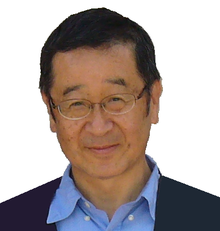Yoshihisa Yamamoto (scientist)
Yoshihisa Yamamoto | |
|---|---|
 | |
| Born | November 21, 1950[5] |
| Citizenship | Japan[1] |
| Alma mater | Tokyo Institute of Technology[5][6]
University of Tokyo[5][6] |
| Known for | Quantum-dot single-photon sources;[7] Differential phase-shift quantum key distribution; Quantum-dot spin qubits;[8] Exciton-polaritons.[9] |
| Awards | Medal of Honour with Purple Ribbon.[1]
Nishina Memorial Prize (1992)[2] |
| Scientific career | |
| Doctoral advisor | Hisayoshi Yanai;[3] Takeshi Kamiya[3] |
| Other academic advisors | Yasuharu Suematsu[3] |
| Doctoral students | Isaac Chuang[4] (MIT); Charles Santori (Verily) |
| Other notable students | Joseph Jacobson (MIT) |
Yoshihisa Yamamoto (山本 喜久, Yamamoto Yoshihisa) is a scientist and engineer and winner of the Medal of Honour with Purple Ribbon.[1][10]
Biography
Yamamoto was born in Tokyo on November 21, 1950.[5] In 1973 he got his B.S. degree from the Tokyo Institute of Technology.[5][6] He continued his studies at the University of Tokyo where he earned a M.S. in 1975 and a Ph.D. in 1978.[5][6] Since 1992 he is a professor of applied physics and electrical engineering at Stanford University in the United States. Since 2003 he also has professorships at the University of Tokyo and the National Institute of Informatics in Tokyo.
Work
Yamamoto is primarily known for his work in the 1980's on optical fiber communications, semiconductor lasers, quantum non-demolition measurement and quantum optical effects. His most prominent work in the 1990's is in semiconductor quantum optics (especially involving microcavities and quantum wells) and quantum effects and noise in electronic devices [4].
During the 2000's, his most prominent work was on the development of optically-active quantum dots as a platform for quantum information processing (both as single-photon sources for quantum cryptography, and as hosts for spin qubits), and for his work on exciton-polaritons. Yamamoto was also active in the development of both theory and realization of quantum key distribution protocols. Landmark papers from this era include the demonstration of indistinguishable photons from a single quantum dot [5]; the proposal for biexciton cascade as a method for generating entangled photons (for QKD) from a single quantum dot [6] (this is the proposal underlying essentially all QD entangled-photon sources, such as those reviewed in [7]), and demonstration of control of a single spin qubit in a quantum dot using optical pulses [8].
During the 2010's, his work has continued on exploring quantum dots as a platform for building both quantum repeaters and quantum computers. One highlight was the co-first demonstration (with Ataç İmamoğlu's group) of entanglement between a spin in a quantum dot and a photon emitted by it [9]. Work on exciton-polaritons continued, and since 2012, Yamamoto has pioneered the development of an optical computer [10], inspired by developments in quantum annealing and adiabatic quantum computing.
References
- ^ a b c David Orenstein: Quantum research earns medal from Japanese emperor. Dated 2005-11-18. Original at stanford.edu, Template:Wayback, Archived copy at WebCite
- ^ Nishihna Memorial Foundation: Recipients of Nishina Memorial Prizes. Retrieved on 2012-11-15. Nishina Original at nishina-mf.or.jp, , Template:Wayback
- ^ a b c Yoshihisa Yamamoto: Curriculum Vitae. Dated January 2005. ["Archived copy" (PDF). Archived from the original (PDF) on July 18, 2010. Retrieved March 28, 2014.
{{cite web}}: Unknown parameter|deadurl=ignored (|url-status=suggested) (help)CS1 maint: archived copy as title (link) Original at stanford.edu] Template:Wayback, Template:Wayback - ^ Yoshihisa Yamamoto: Group members. Retrieved on 2012-10-22. Original at stanford.edu, , Template:Wayback
- ^ a b c d e f g Y. Yamamoto, et al., "Theory of a negative frequency feedback semiconductor laser," IEEE Journal of Quantum Electronics, vol.21, no.12, pp. 1919–1928, Dec 1985
- ^ a b c d Yamamoto: Introduction of researcher. Dated 2004-09-10. Original at nii.ac.jp, Template:Wayback
- ^ [1]
- ^ Theory [2] and experiment [3].
- ^ Nature Physics review (2014)
- ^ NII News: Professor Yoshihisa YAMAMOTO is awarded "Medal with Purple Ribbon". Dated 2005-11-02. Original at nii.ac.jp, , Template:Wayback
